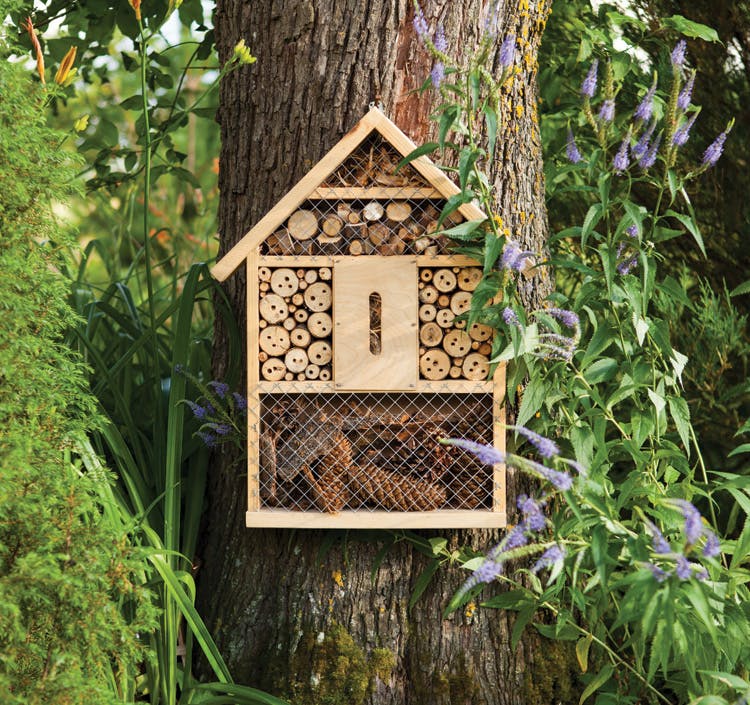Host Friendly Pollinators with a Bee Hotel
It’s the newest trend in insect travel. Everyday people are becoming bee hoteliers by setting up nesting sites, called bee hotels, to attract a variety of the pollinators. The targeted guests are the various genera and species of small, nonaggressive mason and leafcutter bees.
Known as tunnel-nesting bees, they look for dry tunnels in which to lay eggs, seeking out hollow plant stems, abandoned borer-beetle holes, and similar spots. Both mason and leafcutter bees lay their eggs in existing holes, and do not damage structures to make their nests. Both genera also stay close to home, foraging for pollen and nectar within 300 feet of the nest.
Unlike honeybees that live communally in hives, these mild-mannered bees that rarely sting are solitary, going about their business of preparing for the next generation without social interaction. But they like nesting near other members of their species; thus the bee hotel, which is simply a collection of hollow materials mounted in a frame and covered by a roof to keep out the rain. These dwellings provide a dry environment that mimics the conditions the bees prefer. There is a wide selection of bee hotels available for purchase, but it also is easy and inexpensive to make your own.
LIFECYCLE OF TUBE-NESTING BEES
Most mason bees are spring pollinators, emerging from their nests early in the season when temperatures warm to approximately 55 degrees Fahrenheit. Leafcutters emerge later in spring or in early summer. Spring emerging mason bees are excellent pollinators for orchard fruits and nuts, berries, and early spring-blooming flowers. Summer-emerging leafcutters are superb pollinators of summer vegetables and flowers.
Immediately upon emerging, both mason and leafcutter females mate and begin looking for nesting sites. Once a mason bee female finds a suitable tunnel, she seals up the back end with mud (ergo the common name mason bee), and begins collecting pollen and nectar. Leafcutter females do the same, except they seal off the individual cells with leaves and flower petals.
The female carries the pollen-nectar mixture to the nest, rolls it into a ball, positions it at the end of the tunnel, and lays an egg on top so the emerging larva will have nourishment. She then seals off the cell, repeating the process until she’s filled the space. Once she has completed one tunnel, she will begin filling another. This routine will continue for four to six weeks, after which she dies. During her short lifetime, she will pollinate and cross-pollinate thousands of flowers.
Once the male has mated, he is dispensable. To ensure future generations, females control the gender of each egg they lay. Female-bearing eggs are laid at the back of the tunnel where they are less likely to be killed by predators. The male eggs are laid near the opening, so they are the first to emerge, and they can be standing by to mate as the females come out.
The next generation of mason bees will remain in the nest until the following spring. Some leafcutter larvae go into winter hibernation, emerging as adults the following summer. Others hatch right away and emerge as adults the same summer they were laid. These are called second generation bees.
BUILDING YOUR OWN BEE HOTEL
The design of your bee hotel or hotels is limited only by your imagination and the needs of your apian clients. Online, you’ll find hundreds of inspiring images of these structures. The more elaborate ones double as works of art in the garden. Most are attractive, creating a pleasing, patterned focal point in the garden.
Being a bee hotelier is an easy way to boost the population of local pollinators. As a bonus, you’ll have a front-row seat to watch the fascinating lifecycle of these remarkable bees.
Click here for the full article.
Credit: Home by Design Magazine April/May 2017
WRITTEN BY CATRIONA TUDOR ERLER
PHOTOGRAPHY PROVIDED BY ©iStockphoto.com/fotomem



